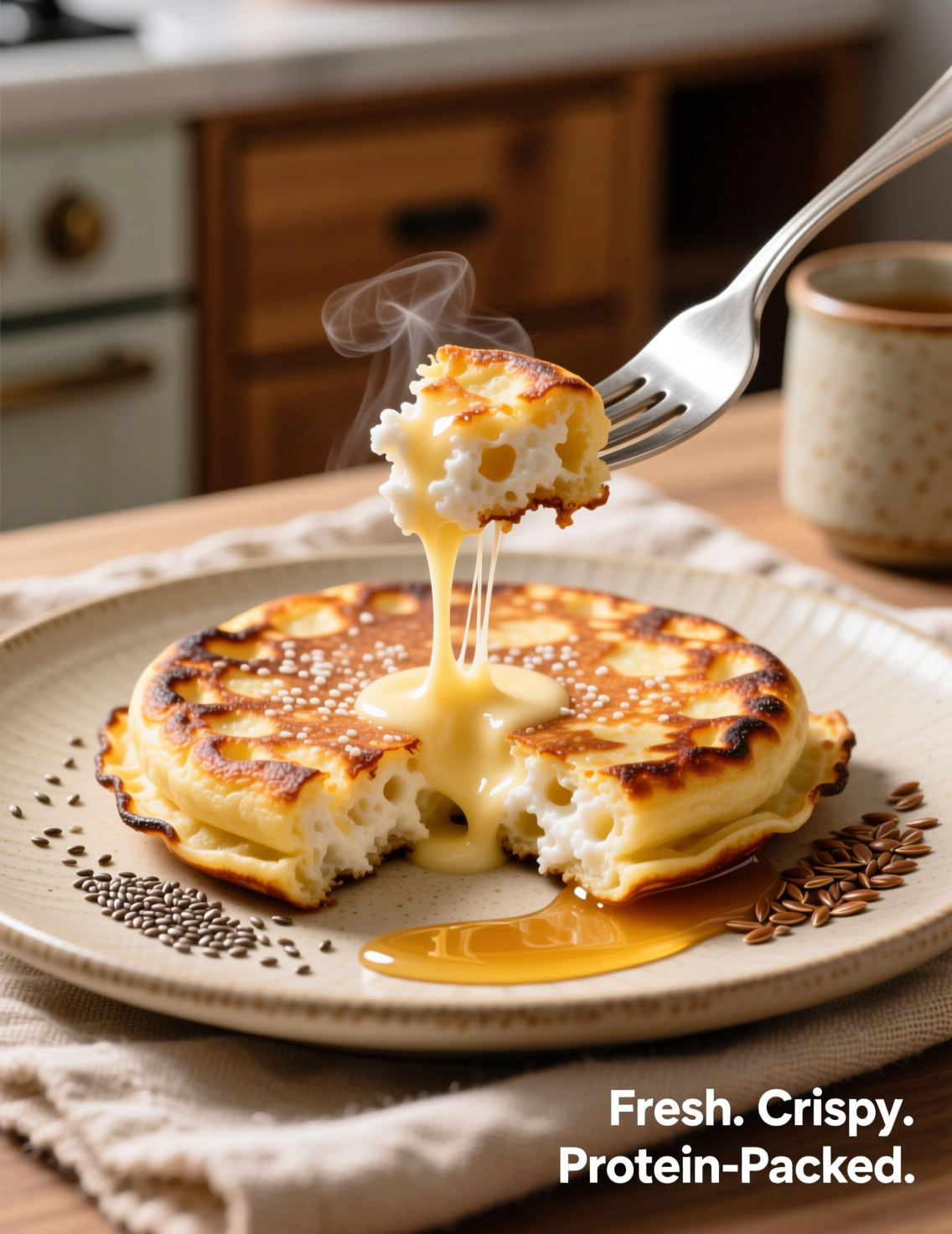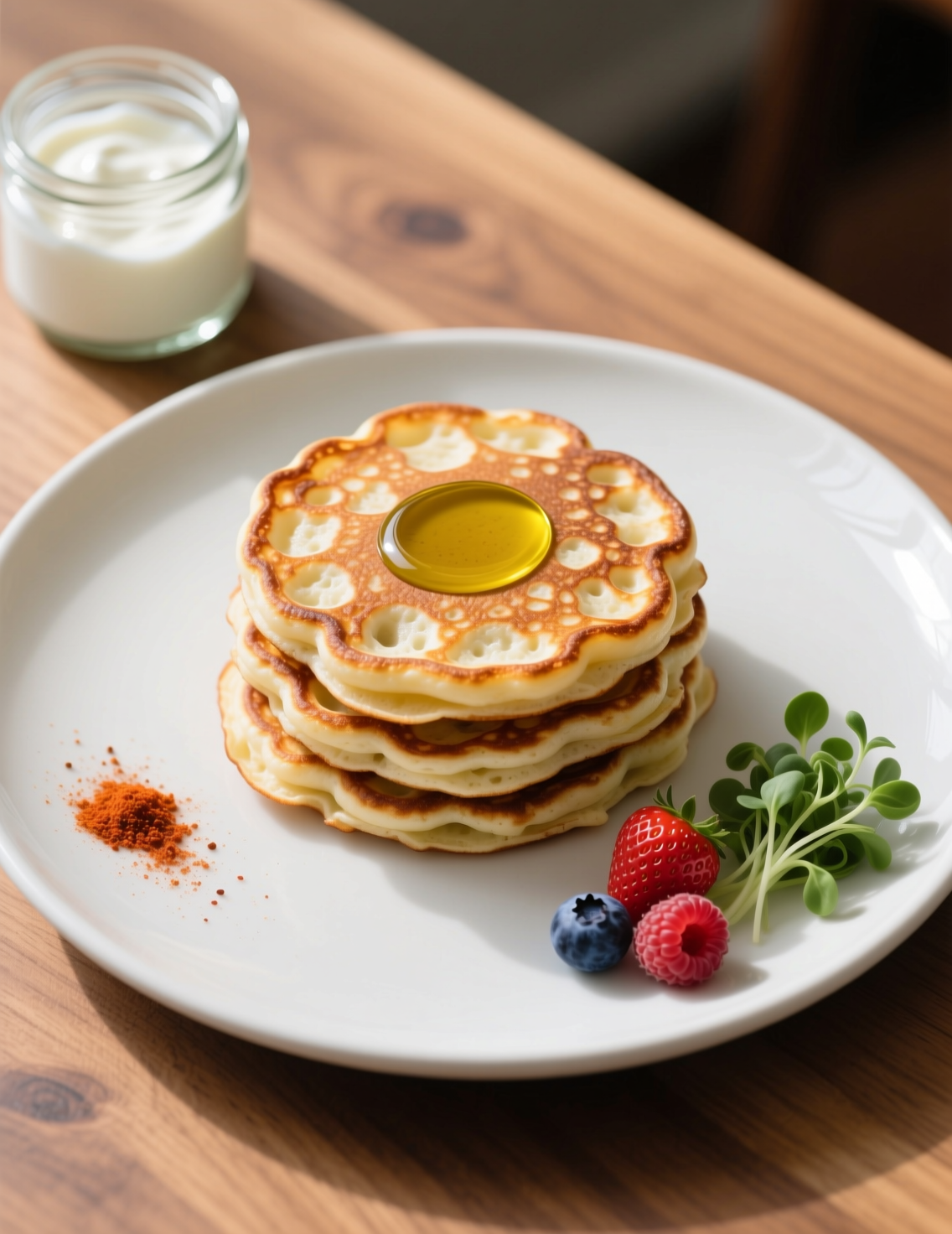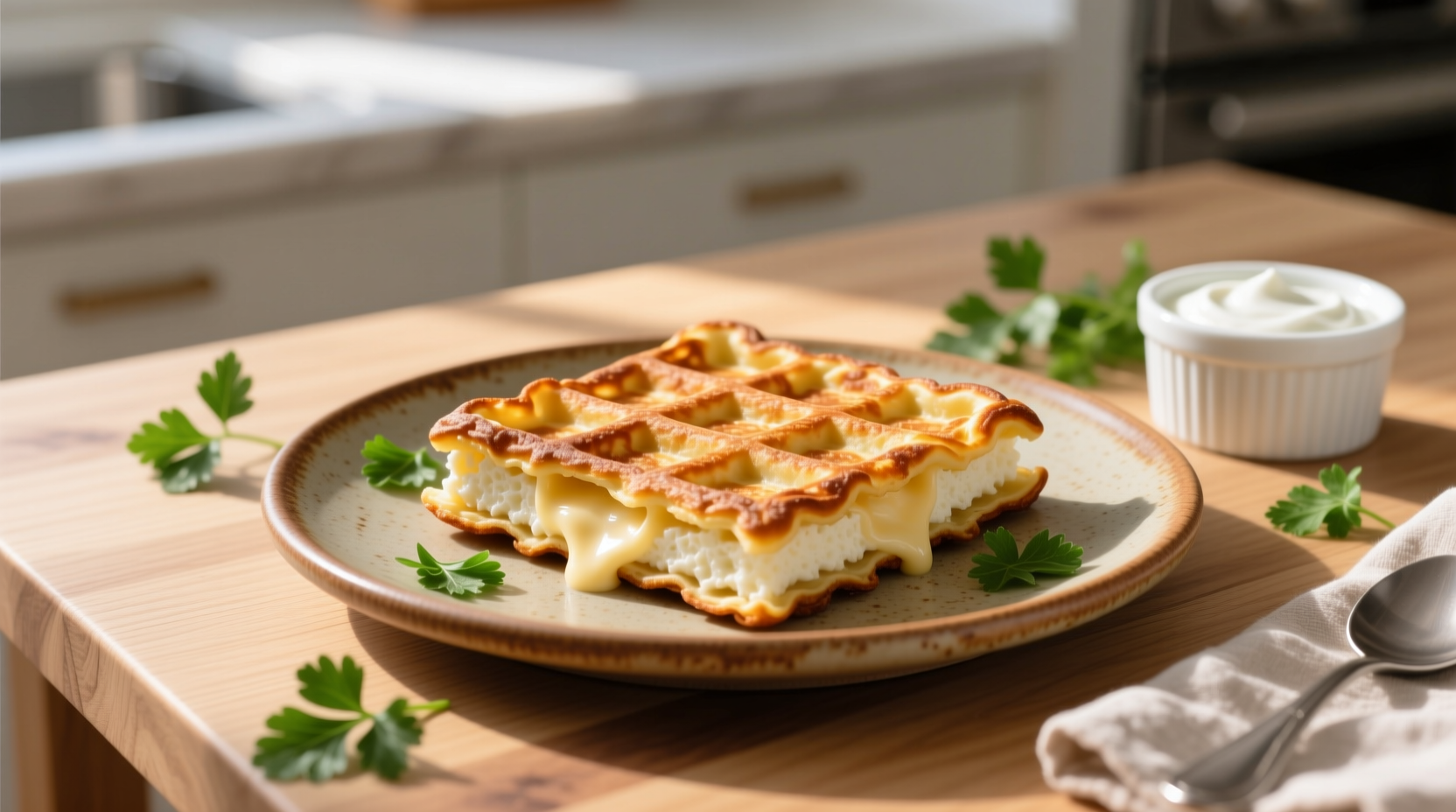You’ve probably heard of chaffles—the low-carb waffles that stormed the keto world. But here’s the real gem hiding in plain sight: the Cottage Cheese Chaffle Recipe. It’s not just another trendy breakfast. It’s science meeting comfort food, with a creamy tang that dances between savory and slightly sweet. And honestly, once you’ve made one, you’ll wonder why cottage cheese ever sat quietly in the corner of your fridge.
This recipe serves 4, but let’s be real—you might not want to share.
What Exactly Is a Chaffle, Anyway?
The word chaffle comes from “cheese” and “waffle.” That’s it. Two simple ingredients gave birth to a low-carb phenomenon. Traditionally, chaffles use shredded cheese and eggs. But swap in cottage cheese, and you suddenly unlock a new level of flavor and texture—light, moist, yet crisp on the outside.
The cottage cheese version isn’t just fluffier. It’s also more balanced nutritionally. You get high protein, lower fat (depending on your cheese choice), and a surprisingly mild flavor that adapts to both sweet and savory toppings.
When you think about it, this is the kind of innovation that only happens when necessity meets curiosity. Someone wanted waffles without the carbs—and got a culinary masterpiece instead.
Why Cottage Cheese Makes It Better
Cottage cheese isn’t just a filler ingredient. It’s a functional protein food. Each half cup packs around 14 grams of protein, a bit of calcium, and those tiny curds that give your chaffle that gentle chew.
It behaves like a binder and a flavor enhancer at once. The mild saltiness helps the batter taste “complete,” while the curds add body. The result? A waffle that doesn’t deflate, sog up, or taste like cardboard after 10 minutes.
It’s also a dream for people watching their macros. Keto, low-carb, high-protein—whatever your style, cottage cheese slides right in. It adds creaminess without extra flour, sugar, or oil.
Ingredients for Cottage Cheese Chaffle (4 Servings)
This version keeps it simple and smart:
- 1 cup cottage cheese (whole milk or low-fat)
- 4 large eggs
- ½ cup shredded mozzarella (or mild cheddar)
- 2 tablespoons almond flour (for structure, optional but recommended)
- ¼ teaspoon baking powder
- Pinch of salt
- Butter or oil spray for greasing
You can tweak this base depending on your mood—add cinnamon and vanilla for breakfast, or garlic powder and herbs for a lunch-friendly version. That’s the beauty of this recipe; it bends to your taste, not the other way around.

Step-by-Step Method
1. Blend it smooth (or don’t).
Throw cottage cheese, eggs, and almond flour into a blender. Pulse it until smooth if you like uniform texture. Or leave it slightly chunky if you want those little cheesy specks. There’s no rule carved in stone here.
2. Mix in cheese and baking powder.
Fold in shredded mozzarella and baking powder. This combo gives your chaffle that lift and crunch. If it feels too thick, add a teaspoon of water or milk—just to loosen it up.
3. Preheat and grease your waffle iron.
Hot and ready—that’s the key. Spray or butter it lightly to prevent sticking.
4. Pour and cook.
Pour enough batter to fill the waffle grid, but don’t overdo it. Cottage cheese expands a bit while cooking. Close the lid and let it cook for 3–4 minutes, or until golden brown and crisp around the edges.
5. Serve hot.
Chaffles are best eaten fresh out of the iron. Stack them, butter them, or drown them in berries if you must.
The Texture Game: Light, Crisp, and Surprising
The cottage cheese changes the texture game. Most chaffles can feel eggy or rubbery, but this one? It’s got that airy lift you’d expect from a traditional waffle, yet with a protein-rich density that satisfies.
If you let it cool for a few minutes on a wire rack, it stays crisp. The curds act like little moisture pockets, keeping the inside tender without making it soggy. That’s chemistry working quietly in your favor.
Nutritional Breakdown (Approx. per Serving)
| Nutrient | Amount |
|---|---|
| Calories | ~180 |
| Protein | 17–20g |
| Fat | 10–12g |
| Carbohydrates | 3–4g |
These numbers make this chaffle a go-to meal for fitness enthusiasts or anyone who loves a balanced, guilt-free dish. You can add toppings like avocado, bacon, or even almond butter without feeling like you’re breaking the rules.
Variations: Because One Chaffle Isn’t Enough
1. Savory Spin
Add minced garlic, chopped chives, and a pinch of pepper flakes. Serve with smoked salmon or poached eggs. Perfect brunch material.
2. Sweet Cottage Dream
Mix in a dash of vanilla, cinnamon, and a teaspoon of erythritol. Top with blueberries and a drizzle of sugar-free syrup. Tastes like dessert pretending to be breakfast.
3. Italian-Inspired
Add oregano, basil, and shredded Parmesan. Serve it with marinara sauce and mozzarella. You’ll forget it’s low-carb entirely.
4. Spicy Jalapeño Twist
Mix chopped jalapeños and cheddar for a fiery, crispy kick. Serve with sour cream on the side.
Every version feels like it’s cheating—but it’s not. That’s the charm.
Expert Insights: The Science Behind the Perfect Chaffle
Here’s where professionals lean in. The structure of a good chaffle depends on coagulation and moisture control. Cottage cheese brings both casein and whey proteins. When heated, these proteins denature and set, creating a stable lattice that traps moisture. That’s why your chaffle doesn’t crumble or collapse.
Adding almond flour helps absorb excess liquid, while baking powder contributes lift through carbon dioxide release. Temperature matters too—too low, and your chaffle steams instead of crisps; too high, and it scorches before cooking through.
Experts recommend medium-high settings—around 375°F (190°C)—for balanced browning and crispness.
Common Mistakes (and How to Avoid Them)
1. Too watery cottage cheese
If your cottage cheese is very liquid, strain it briefly before blending. Otherwise, you’ll get a soggy chaffle.
2. Overfilling the waffle iron
Less is more. Overfilling leads to overflow, uneven cooking, and a mess that’ll test your patience.
3. Not letting it rest
Once cooked, let your chaffle rest for a minute on a rack. Steam escapes, crispness forms. Patience pays.
4. Ignoring seasoning
Even a tiny pinch of salt or spice makes all the difference. Cottage cheese alone can taste flat if you skip it.

Real-World Use: Beyond Breakfast
Professional kitchens are beginning to adapt the chaffle concept for diverse menus. You’ll find chaffle sandwiches at low-carb cafes, savory waffle stacks in bistros, even dessert versions at fitness retreats.
A 2023 study in the Journal of Food Science and Nutrition highlighted how cheese-based batters like this could improve protein satiety levels by up to 25% compared to grain-based equivalents. That’s why nutritionists love it—it fills you up, not out.
Chefs appreciate the versatility. It acts as a base for avocado toast, a bun for burgers, or a crisp alternative to hash browns.
Storage and Reheating Tips
If you somehow have leftovers (which is rare), store them in an airtight container in the fridge for up to 3 days. To reheat, skip the microwave—it’ll soften them. Use a toaster or oven at 350°F for 5 minutes to bring the crispness back.
You can even freeze them between parchment paper. Defrost in the toaster, and you’re good to go.
Emerging Trends: The Rise of Functional Dairy in Cooking
There’s a growing trend in culinary innovation—using dairy not just for flavor but for functionality. Cottage cheese is leading that charge. Once considered old-fashioned, it’s now being reimagined in everything from protein pancakes to high-protein pasta dough.
According to the Dairy Foods Market Report (2024), cottage cheese saw a 37% increase in demand, primarily from the health and wellness sector. Its ability to bind, add moisture, and boost protein without added sugars makes it a chef’s secret weapon.
So yes, the humble chaffle fits perfectly into the modern kitchen narrative—simple, adaptable, and surprisingly elegant.
Conclusion: A Recipe Worth the Hype
The Cottage Cheese Chaffle Recipe isn’t a passing internet trend. It’s a clever, protein-packed evolution of the classic waffle—born from creativity and guided by science. It’s easy, it’s quick, and it’s wildly satisfying.
If you’re a chef, use it as a foundation for your menu innovation. If you’re a home cook, make it your new breakfast ritual. And if you’re just curious, take one bite—you’ll understand what all the quiet excitement’s about.
It’s not just a waffle. It’s a reminder that great cooking happens when tradition dares to experiment.
FAQs
What is a cottage cheese chaffle?
A cottage cheese chaffle is a low-carb waffle made with cottage cheese, eggs, and cheese for a high-protein twist.
How many servings does this recipe make?
This Cottage Cheese Chaffle Recipe makes 4 delicious servings.
Can I make cottage cheese chaffles without almond flour?
Yes, you can skip the almond flour, but it helps improve texture and crispness.
Is cottage cheese good for a keto diet?
Absolutely, cottage cheese is rich in protein and low in carbs, making it ideal for keto-friendly meals.
Can I make the batter ahead of time?
Yes, you can refrigerate the batter for up to 24 hours before cooking.
Why is my chaffle soggy?
Too much moisture from cottage cheese can cause sogginess—strain it before using.
What toppings go best with cottage cheese chaffles?
Try avocado, eggs, berries, sugar-free syrup, or smoked salmon depending on sweet or savory mood.
How do I make the chaffles crispier?
Cook them a little longer and let them rest on a wire rack to stay crisp.
Can I freeze cottage cheese chaffles?
Yes, freeze them between parchment sheets and reheat in a toaster or oven for best results.
Are cottage cheese chaffles suitable for breakfast only?
No, they work great for lunch sandwiches, snacks, or even dinner side dishes.
Can I blend the batter completely smooth?
Yes, blending makes a uniform texture, but leaving it a bit chunky adds nice cheesy bites.
What type of cheese works best with cottage cheese chaffles?
Mozzarella is best for mild flavor, but cheddar or Parmesan adds a bolder taste.
How long should I cook each chaffle?
Cook each chaffle for about 3–4 minutes or until golden brown and crispy.
Can I use nonfat cottage cheese?
Yes, though full-fat versions give better flavor and a richer texture.
Do cottage cheese chaffles taste eggy?
Not really, the cottage cheese and shredded cheese balance out the egg flavor beautifully.

Mariana is a passionate home cook who creates delicious, easy-to-follow recipes for busy people. From energizing breakfasts to satisfying dinners and indulgent desserts, her dishes are designed to fuel both your body and hustle.
When she’s not in the kitchen, she’s exploring new flavors and dreaming up her next recipe to share with the Foodie Hustle community.

